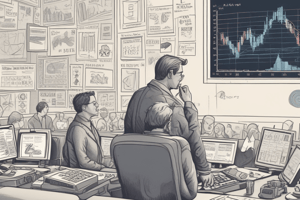Podcast
Questions and Answers
Which of the following scenarios best illustrates the concept of 'loss aversion' in behavioral economics?
Which of the following scenarios best illustrates the concept of 'loss aversion' in behavioral economics?
- Investing in a high-risk stock with the potential for substantial gains, despite the possibility of significant losses.
- Choosing a guaranteed \$50 reward over a 50% chance of winning \$100, even though the expected value is the same.
- Selling a stock immediately after it decreases slightly in value to avoid further losses, even if it might recover. (correct)
- Purchasing insurance to protect against potential losses, even if the premium exceeds the expected value of the payout.
A company is deciding whether to invest in Project A with a 60% chance of a $1 million profit or Project B with a 30% chance of a $3 million profit. Which project has a higher expected monetary value?
A company is deciding whether to invest in Project A with a 60% chance of a $1 million profit or Project B with a 30% chance of a $3 million profit. Which project has a higher expected monetary value?
- Project B, because it has a higher potential profit.
- Project A, because it has a higher probability of success.
- Project B, with an expected value of \$900,000. (correct)
- Project A, with an expected value of \$600,000.
Which cognitive bias is most evident when an investor continues to hold onto a losing investment, hoping it will eventually recover, even after significant evidence suggests it won't?
Which cognitive bias is most evident when an investor continues to hold onto a losing investment, hoping it will eventually recover, even after significant evidence suggests it won't?
- Anchoring bias
- Availability heuristic
- Confirmation bias
- Sunk cost fallacy (correct)
An individual is more likely to purchase ground beef labeled '80% lean' than the same ground beef labeled '20% fat.' This is an example of what cognitive bias?
An individual is more likely to purchase ground beef labeled '80% lean' than the same ground beef labeled '20% fat.' This is an example of what cognitive bias?
A financial analyst excessively relies on recent stock market trends to predict future performance, disregarding historical data spanning several decades. Which bias is most likely affecting the analyst's judgment?
A financial analyst excessively relies on recent stock market trends to predict future performance, disregarding historical data spanning several decades. Which bias is most likely affecting the analyst's judgment?
Flashcards
Loss Aversion
Loss Aversion
The tendency to prefer avoiding losses more than acquiring equivalent gains. Feeling the pain of a loss is more powerful than the pleasure of a gain.
Expected Monetary Value
Expected Monetary Value
The probable financial outcome of a decision, calculated by multiplying each possible outcome by its probability and summing these values.
Sunk Cost Fallacy
Sunk Cost Fallacy
The tendency to continue investing in a losing project to justify resources already spent, rather than cutting losses and moving on.
Framing Effect
Framing Effect
Signup and view all the flashcards
Availability Heuristic
Availability Heuristic
Signup and view all the flashcards





